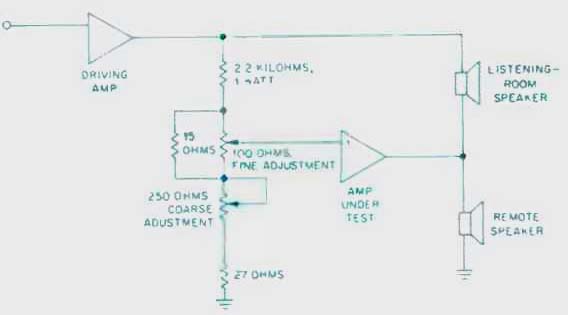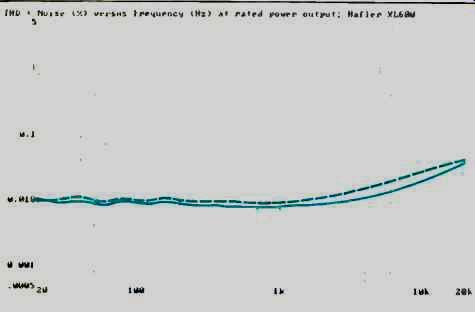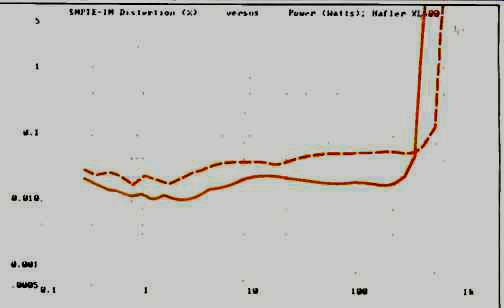
Manufacturer's Specifications:
Power Output: 305 watts per channel into 8 ohms; 450 watts per channel into 4 ohms; bridged mono, 900 watts into 8 ohms; all from 20 Hz to 20 kHz.
THD: 0.05% into 8 ohms; bridged mono, 0.1% into 4 or 8 ohms.
Continuous Power at Clipping: 360 watts per channel into 8 ohms; 500 watts per channel into 4 ohms; 750 watts per channel into 2 ohms; 900 watts per channel into 1 ohm; bridged mono, 1,000 watts into 8 ohms and 1,500 watts into 4 ohms.
All ratings for continuous duty cycle across audio band; depending on load impedance, duration may be thermally limited to several minutes.
SMPTE-IM Distortion: 0.04% at rated power into 8 ohms.
Frequency Response: 10 Hz to 50 kHz, ±0.1 dB. 0.1 Hz to 500 kHz, ±3 dB.
Phase Shift: Less than 0.25° from 20 Hz to 20 kHz.
Slew Rate: 100 V/µS for 130-V peak to-peak square wave.
S/N Ratio: 100 dB, re: rated output into 8 ohms.
Input Sensitivity: 2.6 V for 305 watts output into 8 ohms.
Damping Factor: Greater than 200 at 1 kHz, 150 at 10 kHz (both at 8 ohms).
Dimensions: 19 in. W x 7 in. H x 13 in. D (48.3 cm x 17.8 cm x 33 cm).
Weight: 51 lbs. (23.2 kg).
Price: $1,195.
Company Address: Hafler Div., Rockford Corp., 613 South Rockford Dr., Tempe, Ariz. 85281.
Having known and respected David Hafler for several decades, I was frankly concerned when he sold his company. Would the new owners continue the tradition of straightforward equipment design that characterized Hafler and, before that, Dynaco products? Would the "new" Hafler products offer the same great value that Hailer's earlier amps, preamps, and tuners had for so many years? A few hours spent with the Hafler XL600 power amplifier on my test bench, and a few days spent listening to it, allayed my fears and doubts. The Hailer tradition continues under the new owners, the Rockford Corp.
In designing the XL600, Hafler engineers applied many of the same circuit approaches used in the Model XL-280, which I previously tested for Audio (November 1987). The XL600's circuitry includes a double differential, J-FET, cascoded push-pull input stage and a current-mirror second stage, driving 16 lateral MOS-FET outputs. The direct-coupled circuit is something of a departure from previous Hafler amps in that it employs far less overall feedback. The use of additional MOS-FET output devices increases the low-impedance drive capability, so the amplifier is able to drive difficult speaker loads that require high current levels.

Although only one large power transformer is used, the separate power supplies for each channel employ a total of 72,000 µF of capacitance for improved low-end performance. These electrolytic capacitors are bypassed by smaller capacitors for improved high-frequency performance. A separate supply powers the low-level stages for improved isolation and efficiency. The large heat-sink is cooled by a variable-speed d.c. fan that turns on only when needed and is extremely quiet.
Hafler's Excelinear circuit enables the user to adjust the amplifier for minimum nonlinearity with the speakers which it will normally drive. This adjustment is made by using one channel of the XL600 as a "driving" amp, and a special gain-control circuit (see "Nulling Out Amp Distortion," February 1987) whose schematic is shown in Fig. 1. A control within the amplifier is adjusted until no sound is heard from the listening room speaker. Any difference between the input to, and the output from, the test amp represents some form of distortion which will be audible in the monitor speaker, either as program-related content or as noise. When the signals are identical, no sound will be heard from the monitor speaker. Headphones or a sensitive a.c. voltmeter may be paralleled with the monitor speaker for an even better "null" adjustment. After adjusting one channel of the amp for minimum distortion and phase shift, the amplifier channel positions shown in Fig. 1 are reversed, and the procedure is repeated for the opposite channel. Since my bench measurements were made using purely resistive loads, I did not make this adjustment until I was ready to listen to the amp with my reference Infinity RS 9 Kappa speakers. Accordingly, the static distortion and S/N measurements which will be discussed later in this report were obtained with the factory settings of the Excelinear feature.
Control Layout
A heavy-duty, on/off rocker switch on the front panel is accompanied by a red pilot lamp. To avoid turn-on transients, the XL600 provides a 3-S delay before a relay connects the output terminals. This relay will also disconnect the load if significant d.c. is present at the output or if the heat-sink's short-term temperature is excessive. However, under such conditions the fan will continue to operate.
The rear panel is equipped with two sets of red and black binding posts for speaker connections. Both output and input terminals are gold-plated. A mono/stereo switch is used to change operation from stereo to bridged mono. When mono output is desired, the single speaker load is connected across the red terminals only. A pair of speaker fuse-holders are equipped with 5-ampere fast-blow fuses.
Hafler supplies a pair of spare 10-ampere fuses that are intended for bench-testing or high-power applications. A quick calculation told me that even a 10-ampere fuse would not be enough to enable me to measure power output at low impedances, so I occasionally replaced these with 20-ampere fuses during my bench tests.

Fig. 1--Setup for straight wire differential test.
When the pots are adjusted for minimum sound output from the speaker, only the distortion and the phase and amplitude errors ere heard. For more critical adjustment, a meter of headphone can be used in parallel with the listening room speaker.
Measurements

Fig. 2--Frequency response.
Figure 2 shows the frequency response of the XL600, from 10 Hz to 200 kHz. Considering that at no frequency within this range did the amplifier exhibit any "minus" readings, the slight rise of +0.2 dB at 50 kHz may be considered as meeting Hafler's published specification of ±0.1 dB. There was virtually no deviation from perfectly flat response over the audible range from 20 Hz to 20 kHz. The slight rise of + 1.3 dB at 200 kHz was of no particular concern to me, inasmuch as I could detect no signs of instability for any of the load impedances or drive conditions employed during my bench or listening tests.

Fig. 3--THD + N vs. power output per channel into 8- and 4-ohm loads, for
three frequencies. The curves for 20 Hz and 1 kHz are identical.
Figure 3 shows how THD + N varied with increasing power output, using 8- and 4-ohm loads. At the rated output of 305 watts per channel into 8 ohms, THD + N was only 0.006% at 20 Hz and 1 kHz. THD was a bit higher at 20 kHz, measuring 0.023% for rated output. With a 4-ohm load, THD + N was 0.017% at 20 Hz and 1 kHz, and 0.04% at 20 kHz, for the rated output of 450 watts per channel.
Figure 4 shows how THD + N varied as a function of frequency, keeping power output constant at its rated levels (305 watts per channel for 8 ohms, 450 watts per channel for 4 ohms), with both channels driven. The slight discrepancies between the readings in Fig. 3 and Fig. 4 at 20 Hz, 1 kHz, and 20 kHz are probably caused by slight temperature variations which occurred between the times when I made each of these measurements. In any event, THD + N was well below published specifications in both instances, and the 8- and 4-ohm graphs are quite similar to each other. How SMPTE-IM distortion varied as power output was increased from below 1 watt to above clipping levels is shown in Fig. 5. At 305 watts per channel, with an 8-ohm load connected, SMPTE IM measured precisely 0.04%, as claimed by Hafler. No specification was supplied for 4-ohm loads, but my results show that it was about 0.1% at 450 watts per channel. CCIF-IM, or twin-tone, distortion is caused by spurious beats between two frequencies that are 1 kHz apart. As Fig. 6 shows, CCIF IM was less than 0.002% for 305 watts per channel into 8 ohms and just over 0.003% at 450 watts per channel into 4 ohms.
There was no way to adjust the output level of the XL600 so that it would deliver 1 watt into 8-ohm loads for an input of 0.5 V, the conditions for testing an amp's S/N in accordance with EIA Standards. Therefore, I measured S/N with respect to 1 watt output by adjusting the signal source to the value needed to produce this level. The XL600 required 150 mV, which I thought was rather high, as this would require 2.6 V input for full rated output at 8 ohms. However, most preamplifiers can deliver this voltage without any noticeable increase in distortion. In any case, the XL600's A-weighted S/N ratio, referred to 1 watt, was 93.11 dB. If you want to reference this to rated output of 305 watts into 8 ohms, add around 25 dB to my result, for over 118 dB of S/N. If that sounds too good to be true compared with Hafler's claim of 100 dB, bear in mind that Haller quotes unweighted S/N, whereas the EIA Standard calls for A-weighting.
Damping factor, at 50 Hz and referred to 8-ohm loads, was 153. After I had completed the tests of continuous power, I made some short-term measurements to determine clipping levels at various load impedances. For an 8-ohm load, severe clipping occurred at levels approaching 400 watts per channel. With a 4-ohm load, clipping was evident at about 475 watts per channel, and at 750 watts per channel for a 2-ohm load. I did not attempt to drive this amplifier into clipping for a 1-ohm load, simply because of fuse limitations in the adjustable line-voltage transformer I use to maintain constant 120 V a.c. during bench tests. In the bridged mono mode, using an 8-ohm load, clipping occurred at 1,050 watts. Again because of my transformer's fuse limitations, no attempt was made to determine clipping level using 4 ohms in the bridged mode. I did confirm the XL600's ability to deliver more than 900 watts of power into 8 ohms, in the bridged mono mode, with less than 0.1% THD. Reverting to stereo operation with 8-ohm loading, I determined that this amplifier's dynamic headroom was an impressively high 2.3 dB.

Fig. 4--THD + N vs. frequency, at rated output of 305 watts per channel
into 8 ohms (solid curve) and 450 watts per channel into 4 ohms (dashed curve).

Fig. 5--SMPTE-IM distortion vs. power output for 8-ohm load (solid curve)
and 4-ohm load (dashed curve).

Fig. 6--CCIF-IM (twin tone) distortion vs. power output for 8-ohm load (solid
curve) and 4-ohm load (dashed curve).
Use and Listening Tests
I installed the Hafler XL600 in my reference listening system and, since I was also testing a couple of excellent CD players--the Philips CD880 and the Onkyo DX-G10. I used these components as program sources for the listening tests and final adjustment of the Excelinear circuitry. I should point out that the special gain-adjustment circuit shown in Fig. 1 had been supplied earlier, when I tested Hafler's XL-280 amp.
I wanted a consistently loud piece of music with which to make the final nulling adjustments, since I assumed that the louder music, with its more limited dynamic range, would enable me to adjust the internal potentiometers and trimmer capacitors more precisely. I therefore chose that old warhorse of an overture by Von Suppé, "Light Cavalry," as recorded by the Utah Symphony Orchestra on a Pro-Arte Compact Disc (CDD 402). The nulling adjustment was amazingly easy to make-even easier than I remembered from my tests of the lower-powered XL-280. Just for the fun of it, I then played some softer chamber music, using a Delos disc entitled Brahms/Schumann Soiree (D/CD 3025). Surprisingly, the adjustment was just as easy to perform with equal precision. I subsequently used an a.c. voltmeter to see if I could come even closer to a perfect null. I could not, so audible adjustment using headphones would seem to be just as accurate as with test instruments.
I was curious to find out if, indeed, a different adjustment would be required with a different set of speakers, as Hafler states in the owner's manual. To verify this, I used my other reference speakers, the KEF 105.2s. (I had not attempted this sort of check when I last used the Hafler Excelinear technique.) Sure enough, while the readjustment was quite minimal with this second set of speakers, it was needed.
The best way to characterize the sound of the XL600 would be to describe it as absolutely non-grating and as delivering high-frequency peaks that did not tend to be the least bit brittle or irritating. I hate to use the term "tube-like" sound, but I suspect this is just how some listeners would describe the Hafler XL600's sonic reproduction. Above all, this is an amp that simply will not run out of power with any pair of loudspeakers intended for high-fidelity home audio applications. More than that, the output signal the XL600 delivers into actual loudspeaker loads is as close a match to its input signal as I've seen in any amplifier I have ever tested.
-Leonard Feldman
(Adapted from Audio magazine, Feb. 1989)
Also see:
Hafler Trans-Nova 9505 Amplifier (Apr. 1996)
Hafler DH-330 FM Tuner (Nov. 1986)
Hafler XL-280 Amplifier (Nov. 1987)
= = = =